Quick Links
Did you know that including a well-made video on your landing page can increase your conversions by 80%?
Or that 95% of people have watched explainer videos to learn more about a product or service?
So if you aren’t leveraging the power of video for your marketing campaigns, now is the time to create a video marketing strategy.
It’s the framework that will help you determine which types of videos will work best for your marketing goals.
For example, do you want to attract a larger audience, better engage your viewers, or generate more sales?
Once you know your goals, you can begin forming your strategy around them.
But what if you don’t know the first thing about video production? How do you budget for videos? What resources do you need?
You’re certainly not alone if you’ve been asking yourself these questions. That’s why we put together this extensive guide on putting together a video marketing strategy for your business.
Also, don’t forget to take advantage of our full-feature HD video service as a source for your video content.
Let’s get started!
Step #1: Ask Yourself the Right Questions
Before you do anything else, sit down and ask yourself what your marketing goals are for video creation. In other words, what do you hope to achieve?
To come up with your goals, you’ll need to start by asking yourself the right questions. Try starting with these five:
- Who is your target audience?
- Which stage of the marketing funnel are they in?
- How can you solve their pain points?
- Which marketing channels are you using to reach them?
- Which metrics and analytics will you use to measure your success?
In particular, answering the first three is the most crucial, as these questions are necessary for any type of marketing campaign.
Above all else, you’ll need to identify your target audience and nail your messaging. Otherwise, your video will fall on deaf ears, and you’ll wind up with nothing to show for the money you spent creating videos.
Who is your target audience?
You need to know who you’re speaking to when creating videos. If your business doesn’t already have a target audience, niche, or buyer persona – you’ll need to find one now. If you do, then you’re all set for this section.
Your target audience is the people whose problems you solve with your products and services. They’re also the people most likely to find your video content interesting.
If you sell gardening tools, your target audience would be gardeners and landscapers. If you provide relaxing massages, you’ll want to target people that are tense and stressed out.
You’ll want to ask yourself three questions about your audience:
- Who is your product or service for?
- What’s the purpose of the video?
- Where do your target demographics spend time online?
Answering these three questions will identify your buyer persona, pinpoint the stage of the marketing funnel, and teach you where to distribute your video.
As an example, let’s say that you sell guitars online. Your target audience is guitarists, and your goal is to reach more of them.
That’s when you decide to make animated videos breaking down popular songs on guitar to engage with a broader audience. (The Attract level of the funnel – more on that below).
You share the video on guitar forums, guitar-related social media pages, and guitar Reddit groups for distribution.
As you can see, simply answering those three questions did a majority of the work in coming up with an audience and subject matter for your videos.
Attract, engage, nurture, or delight?
Once you have your target audience in mind, you’ll need to pinpoint the goal for each video that you create.
In general, most video marketing strategies fit into one of the following four categories:
- Attract. If you want to heighten your brand awareness and reach potential customers (like the example above), the video’s goal is to attract.
- Engage. Do you want to educate your prospects on new products, services, and concepts with your videos? If so, then your goal is to engage.
- Nurture. Your videos aim to nurture if you want to increase your conversion rate and convince customers to make purchases.
- Delight. If you want to thank your existing customers with entertaining video content to ensure they keep coming back, your goal is to delight.
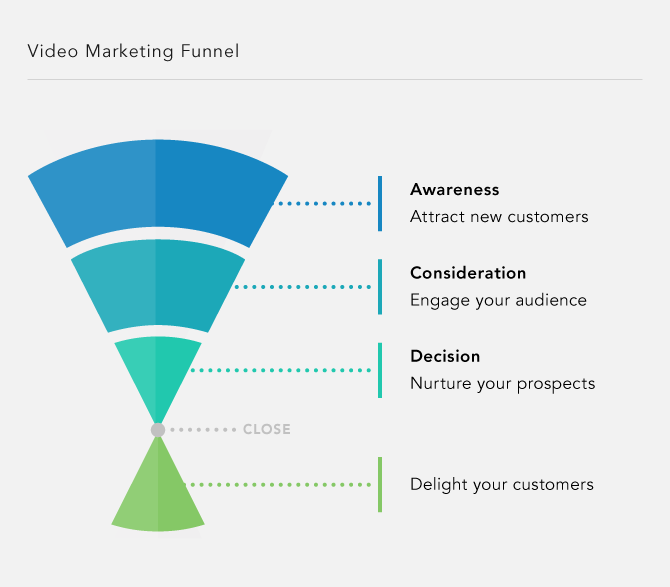
Your goals may only touch on one or a few of these categories, or they may include all the above.
What are your goals?
It’s best to be as detailed as possible when clarifying your goals.
An actionable goal should have a target metric and a specific date, such as:
“Our goal is to increase our click-through rate by 200% in 12 months by including videos in our email marketing campaigns.”
Now you have a goal that will hold you accountable for the end result. Not only that, but you have a clear timeline in place (12 months) – and you know what you have to do to make it happen (include videos).
If you want to see improvements at each stage of the funnel, you should make videos for each category (Attract, Engage, Nurture, Delight). That way, you’ll actively attract new customers while engaging, nurturing, and delighting existing ones.
Yet, you may only require a few videos from each category. It will also depend on the budget you have set aside for video creation. If you can only spare the funds to create a handful of videos, make sure that they go toward the most important category for meeting your goals.
Once you’ve determined your primary goals, you can get far more detailed with your video marketing strategy.
As soon as you’ve got everything set, you can use the user-friendly one-page template that we designed to help you create the perfect video strategy.
Step #2: How to Nail Your Messaging and Storytelling
Now that you have clearly defined goals for your videos, you’ll need to decide what stories you want your videos to tell. This is where it helps to sit down and clearly define your messaging.
Here are the core components of your messaging:
- The pain points of your target audience and how you can solve them.
- The values and mission statement of your company.
- Specific language and terms that you use.
- The tone of voice that you use in your videos.
Now that you’ve got your messaging down, you’ll need to incorporate the primary elements of storytelling.
How to tell a great story
In a nutshell, your story structure will be identical to that of a Hollywood movie – albeit with a few marketing tweaks:
- Start by identifying your protagonist. Instead of Luke Skywalker, the hero of your story is someone from your target demographic – an ‘every person that relates to your audience (i.e., a fitness guru if you’re in the health and wellness niche)
- Next, no story is interesting without a conflict. In the case of video marketing, the conflict is your customer’s problem.
- The conflict gives way to the quest, which is introducing your product or service that will save the day. The quest includes educating your customers on how your products and services work.
- Lastly, putting your product or service into action will provide the resolution to the story.
Don’t forget to include emotion
Nobody likes to watch robotic corporate videos that have no semblance of humanity.
So if your video marketing strategy is to film talking heads spewing out tired business diatribes – you’re going about it the wrong way.
Just as with film or television, people respond to emotions above all else when watching video content – and there’s plenty of evidence to support this.
The Ehrenberg-Bass Institute for Marketing Science found that videos that exhibit high-arousal emotions ‘cut through the clutter’ and are most remembered by viewers.
So if you want your video to have a powerful impact on your viewers, you should decide which emotions you want to elicit from each video. For example, injecting a fair amount of humor into a video aimed at widening your audience can help you break the ice with new prospects.
Conversely, if you’re raising awareness for a nonprofit that’s doing crucial work to end poverty – you may want to elicit empathy from your viewers by making them confront a hard truth.
P&G’s ‘Thank You, Mom’ Campaign
Here’s an example of the power of emotion in video marketing.
In 2010, Procter & Gamble wanted to create a video ad campaign for the upcoming Olympics that was in line with their brand mission – to touch people’s lives and form an emotional connection with customers.
To do so, they focused on celebrating the mothers of Olympic athletes with their ‘Thank You, Mom’ campaign. The video was a touching thank you to the moms of athletes and moms everywhere.
The campaign proved to be the most successful ad campaign in the organization’s 175+ year history. The video ad campaign generated $500 million in global sales, created 76 billion media impressions, and was viewed over 74 million times.
As you can see, eliciting emotions from your audience is a potent tool that you shouldn’t ignore.
One study even found that customers with emotional connections to brands had a 306% higher lifetime value than those who were only satisfied. The more you can get your customers emotionally invested in your brand, the better – and videos are an excellent way to do just that.
Step #3: Develop a Detailed Roadmap for Your Videos
Video production is a process that demands structure, so you’ll need a timeline and a roadmap to navigate its waters safely. In fact, you’ll need to keep track of several timelines for each video.
For example, movie studios track the progress of films according to three timelines, and you should too:
- Pre-production (2 – 3 weeks). This phase involves creative planning, scriptwriting, storyboarding, and creative approval processes. Everything you need to do before the camera starts rolling falls under the umbrella of pre-production.
- Production (1 – 2 weeks). As soon as the lights go up and the camera turns on, you’ve entered the production phase. You’ll want to incorporate the tightest planning here, as this is the most expensive part of the process. For most digital marketing videos, you should be able to knock out the production phase in about a week.
- Post-production (2 – 3 weeks). Once all the footage is shot, and the crew wraps things up, you’re now in post-production. During this phase, you will edit the footage and decide if re-shoots are necessary. If you discover any missing pieces, you may need to re-enter the production phase briefly. If you’ve got everything you need, you’ll be ready to distribute the video once the editing is complete.
You should keep track of these three timelines for each video you produce. That’s the most reliable way to stay organized and meet all your deadlines. Also, at any given time, you’ll be able to see which stage each video is in (i.e., this one is going into production while another product video enters post-production).
Mapping it out
Besides a timeline, creating a roadmap will help you visualize the goals of your overall video marketing strategy.
In other words, the roadmap contains all your plans for videos that will attract, engage, nurture, and delight.
When married, your roadmap and timeline will look something like this:
#1: A brand video for the attract phase – an entertaining intro to your company and the problems that you solve.
- Planning, writing, and scheduling: 2 weeks
- Shooting the content: 1 week
- Editing, exporting, and distributing: 2 weeks
#2: A how-to video for the engage phase that demonstrates how to use a new product.
- Gathering materials, casting, and writing: 2 weeks
- Shooting the video: 2 days
- Editing, exporting, and distributing: 1 week
As you can see, this is an easy way to keep track of which videos you’re producing and how long it will take to create them. All you have to do is check the boxes as you complete each stage of the production process for each video.
Step #4: Don’t Forget Your Budget
For startups eager to hit the ground running with video content but don’t have the budget for it – guerilla filmmaking is the way to go.
You can create successful YouTube videos by only using your iPhone and some basic editing software in today’s age. Granted, you’ll be pretty limited in what you can pull off, but it’s still doable.
For larger companies, you’ll want to pump some money into your video marketing campaign, but how much?
If you want to create detailed explainer videos and how-tos with crisp visuals and professional graphics – you’ll want to hire a video production company.
You should also consider hiring freelance editors, sound designers, and composers to do additional work on your videos.
How much each service will cost will depend on the scope of the video and the talent/reputation of the company. Prices can range from $1,000 to $500,000 – as there is no set price for video production.
That’s why it’s best to shop around here and compare prices to find the best deal.
According to Smart Insights, $20,000 is the average budget for a video marketing campaign. If you aren’t sure what’s right for your business, you can use our free business valuation tool.
Step #5: Decide Which Type of Video to Make
Testimonial Videos
A customer testimonial video carries a lot of clout amongst customers. After all, 93% of customers say that online reviews influence their purchasing decisions – and a testimonial video is a review you can watch.
That’s because people will trust the words of an actual customer more than any self-promotional tactic.
These videos are powerful because they prove to your prospects that your products and services do what you say they will.
If you’ve done any recent case studies on customers, now is the time to use them. Focusing on a single case study is an excellent technique for creating a testimonial video. Here are a few more tips for shooting testimonials:
- Capture something authentic. People can tell if a moment is genuine or not. If you have the chance to film customer reactions to trying your product for the first time, their authentic positive response will do all the selling legwork for you.
- Include the results. If you’ve changed a customer’s life with your product or service, you should include the results in the video. Before and after shots work particularly well here.
- Focus on the buyer’s journey. Remember to take your viewers on a journey by telling a complete story. Your case study is your protagonist, so be sure to show how you resolved a conflict in their life.
- Production quality matters. A testimonial video aims to make your company look as good as possible. As such, you want to reflect a professional image by producing a high-quality video.
A well-produced testimonial video serves two purposes. For one, it reflects staunch professionalism in your company, as you clearly care about quality. Secondly, customers are more likely to trust a professionally made video than a low-quality one.
Including all these components will ensure that you wind up with a testimonial video that has a powerful effect on your prospects.
Commercials
If you’ve spent any time watching TV or YouTube, then you’re more than familiar with commercials. They’re brief video ads that primarily serve to attract new customers.
In particular, the goal of any commercial is to stick in people’s minds above all else.
You’ve won half the battle if you can get someone to remember your catchy jingle, logo, or tagline.
That’s why commercials are so effective at widening your reach.
In today’s age, commercials appear on social media channels like Facebook and Tik Tok, YouTube, streaming services (Hulu and Netflix), and good old television.
So if you want to gain more followers or break into a new demographic, you should invest in producing commercials.
Besides using paid channels, you can also run your commercials on your homepage and website for some free advertising.
Here are some tips for producing memorable commercials:
- Use bold visuals. This is where it helps to have the help of a video production company. Commercials aim to entertain with striking imagery ranging from the beautiful to the macabre. That’s why the quality of your visuals matters so much for a commercial.
- Don’t forget the music. Your audio is equally as important as the video (or even more so). Some of the most memorable ad campaigns of all time featured simple, catchy jingles. If your commercial doesn’t have any music, you should hire a composer to change that.
- Include a clear call to action. There’s no need to hide the intent behind a commercial, as everyone knows it’s an advertisement. You’ll want to include bold calls to action that will let your prospects know what to do next. You can encourage them to check out your products or visit your website to learn more.
Commercials are still a powerful marketing tool, especially when you include all the tips you see above.
Explainer/How-To Videos
Are you looking to engage with your audience? If so, you’ll want to produce at least one explainer video.
What’s that?
An explainer video lets your audience know how your products or services work and demonstrates the problems they solve.
A how-to video is similar but different in that it primarily focuses on teaching viewers how to do something in a series of steps.
The ideal explainer video briefly introduces your company and then gets straight to the point. In other words, you demonstrate a customer pain point and then explain how your product or service solves it.
An example of an explainer video
Let’s say you sell a water bottle with special insulation, so the liquid inside stays cold for hours – and you want to create an explainer video for it.
To start, you open on a jogger running during the day’s peak heat. Sweat pours down their face, and they reach for their water bottle. After they take a swig, they spit it out because it’s as hot as a cup of coffee.
That’s when you introduce your product and quickly demonstrate how it works. A spokesperson takes a minute or two to explain the technology. After that, you show the same jogger during the heat of the day – only this time – they have your special water bottle. They take a cool and refreshing drink, and the video ends.
That’s an example of a successful explainer video that incorporates the story elements that we brought up before. It demonstrates a customer pain point, explains why your product is the solution, and then shows the resolution to the conflict.
Social Media Content
As of 2022, there are 3.96 billion users on social media platforms worldwide – and they’re all exposed to video content.
In the early days, social media was primarily text-based. Now there’s Facebook video, Instagram live, Snapchat, and others. Then, of course, there’s the behemoth that is Tik Tok – a platform that thrives off short-form video content.
If you’re serious about your video marketing strategy – you’ll want to include videos on your social media accounts.
That goes beyond paying to run video ads on Facebook and YouTube. Instead, you should create videos primarily to embed and share on social media.
These videos should be SHORT, so aim for a minute or less.
While they’re shorter in length, the principles of video production still apply here. You’ll want to use consistent messaging, tell a story, and elicit emotions from your viewers. The catch is that you’ll have less time to do it.
Visuals matter more than audio for social media videos.
Why’s that?
It’s due to the features of platforms like Tik Tok and YouTube. They have muted autoplay and video looping, so you’ll want your visuals to do most of the work. Including subtitles with your video is also a good idea, as prospects can watch your video without sound and still receive its core message.
Product videos
Lastly, product videos are quite popular, especially for eCommerce stores. A product video will show your product in action while breaking down its features and selling points.
A well-made product video can be compelling for customers. That’s because they get to physically see your product perform its functions in real-time – which is a lot more potent than simply seeing images of it.
It’s best to keep product videos concise, so you don’t lose your viewers’ attention. The sweet spot tends to be 30 seconds or less. You should quickly present your product, list all the reasons why it rises above the competition, and then provide a CTA, so your prospects know what to do next.
Where should you distribute your product videos?
You can use paid advertising channels such as YouTube or Google Ads or post them to your website and social media channels. You can even use product videos in your email marketing campaigns.
Fun fact: 8 out of 10 customers report buying a piece of software or an app after watching a product video.
Step #6: Decide Which Style of Video to Use
A video’s style differs from its type. In particular, the style has to do with the way you present your information.
For example, will you use actors, animation, studio sets, or live locations?
Let’s say that your type is a product video. The style could then be animated, acted out, presented with graphs, and more.
You can also choose to tell a narrative or a documentary-style of story.
Here’s a look at some of the most common styles for video marketing.
Narrative Style
Do you want to tell a story the same way that Hollywood movies do? If so, then you’re seeking the narrative style of video. That’s where you tell a fictional story with characters, conflict, and resolution to promote your brand.
What kind of narratives can you tell?
It can be anything from telling your brand’s story to a day in the life of a made-up superhero.
There are no limitations on which kinds of stories you can tell, so feel free to use the full force of your creativity.
The narrative style works best for commercials and social media content. You won’t have much use in telling a narrative story inside a product or explainer video.
Like commercials, narrative videos work best during the attraction phase. They’re great for introducing new prospects to your brand.
What should go into your narrative stories?
- Relatability
- Solving customer problems
- Eliciting emotions (sadness at the pain point, joy at the resolution achieved by the product)
- A protagonist that relates to your target demographic
- Entertainment and fun
These components will help you form an engaging narrative video that sticks in the minds of your customers.
Documentary Style
You’re shooting a documentary if you aren’t making up a story but are following a real story. The goal here is to capture real life in its natural form with as few interruptions as possible.
The documentary-style works wonders for testimonial videos and case studies.
Since you’re showing real-life success stories, it’s best to represent them in a documentary format.
Trademarks of the documentary style include shooting on location, conducting interviews, and shooting dramatic recreations. You can and should include all of these components within your testimonials and case study videos.
For example, if your product revolutionized how your protagonist did their job during the day – you can include a dramatic recreation. That’s where you film them performing their daily tasks at work while showcasing how your product helps them out and saves time.
It’s best to keep your documentaries short as well. If you have hours of interview footage, condense it to the essential soundbites. A one or two-minute documentary is long enough to hold customers’ attention, especially if it’s well-made.
Instead of resolving conflict, you don’t have to worry about a three-act structure with a documentary. Instead, you just need to answer three questions: what, why, and how? What is the focus of the video? Why does it matter to the customer? How can they learn more?
Animation
Animated videos are incredibly versatile – as every style of video can work in an animated format. From product videos to explainer videos, animation can pull them all off with ease.
Animated content also tends to be less expensive than other forms of video. That’s because it doesn’t take much in the way of human resources or costly equipment.
The catch?
The animation will take nearly twice as long to produce due to the technical and time-consuming nature of the process. So if you’ve got animated videos on the docket, you’ll need to allow extra time for the production phase.
Yet, animated videos can captivate audiences and retain their attention better than most. A successful real-world example is Compare the Market’s Meerkat campaign. These animated videos sparked a phenomenon and contributed to 70% of the company’s market growth in the UK.
Step #7: Use a Reliable Video Production Company for Professional Shooting
If you do any research on the costs of video production equipment, you’ll soon realize how unbelievably expensive it is to buy cameras, tripods, and editing software. A modern digital camera can cost $100,000+, for example.
For most companies, it’s unrealistic and would be a waste of money to keep Hollywood-grade camera equipment lying around only to shoot online video.
Instead, it’s far more cost-effective to hire a high-quality video production company to do the shooting for you. The great thing about these companies is that they have all the expensive equipment, so you don’t have to buy anything.
Moreover, they’re trained professionals and know how to use the equipment properly.
The power of working with a video production company
If your staff has no experience shooting videos, it’s best to leave it to the pros. They will know how to achieve crisp, clean images that won’t take too much space. They’re also used to the challenges that pop up during production, something that can prove to be overwhelming for beginners.
For more elaborate videos, production companies will know how to create shots that cut well together, as well as using complicated visual effects and lighting techniques.
Production companies will also know how to compose shots, white balance the image correctly, and deal with continuity errors.
Another perk is that they can often handle both production and post-production.
That will significantly reduce the amount of work your staff has to do, which is a plus. All you’ll have to take care of is writing the script and distributing the video once complete.
Forming a lasting relationship with a production company
When forming a relationship with a video production company, your goal should be to be in it for the long term. It’s best to have the capacity to create a ton of video content instead of only producing a commercial that you run once.
The more video content you can create with the company, the more value you’ll get for the money you spend.
That’s especially true for videos that will accompany your blog content. While SEO takes some time to get going, once it does, its effects will last far into the future.
That means the videos you work on today can continue to make money for you tomorrow. As long as your posts and videos continue to rank on page #1 of Google and YouTube, they’ll continue to generate organic traffic for you.
Bear in mind that it’s likely that you’ll only outsource production for the most crucial videos that you’ll share on your homepage and landing pages.
When it comes to creating videos for social media marketing, you don’t have to worry about the quality as much – so it’s usually fine to shoot these yourself (i.e., company vlogs).
Yet, you’ll still want to make sure your vlogs and quick social media videos have consistent messaging and elicit emotions from your viewers. The message is what counts here, not so much the cinematic quality of the visuals.
Pro tip: If you’re engaging in a video ads campaign specifically for social media platforms – it can be worth outsourcing to a high-quality video production company to make sure that you nail the look and tone of the content.
Step #8: Tailor Your Video Content for Each Goal
By now, you should have clearly defined goals for your video marketing strategy. You should also have a timeline, budget, type, and style of video picked out.
The final step is to align your planned videos with your marketing goals and tie them to each funnel stage.
To make things easier, here’s a guide breaking down which videos work best for each stage of the funnel:
Attract Stage
- Commercials
- Industry videos
- Educational videos
- Product or service videos
Engage Stage
- Brand videos
- ‘Day in the life vlogs and consumer lifestyle videos
- Testimonial videos and case studies
- Explainer videos, tutorials, and how-tos
Nurture Stage
- Social media videos, short videos, Tik Toks
- Customer spotlight videos (highlighting a customer success story)
- FAQ videos (answering consumer questions about your products and services)
- Product review videos (reviewing your products or third-party products and services)
Delight Stage
-
- Thank You/Welcome Videos: welcoming new visitors and thanking customers
- Bonus tutorial: a free video explaining how to use one of your products
- Pro tips and tricks: insider content that teaches viewers new skills and shortcuts
- Event videos: these are highlights and recaps of your corporate events
Do your best to diversify your content so you’re not constantly repeating the same thing.An ideal video marketing strategy will combine all the content and video styles you see above – especially early on. That allows you to monitor and test each video type to see what sticks with your target audience and helps you achieve your goals.
Check out our learning hub for more on content marketing and how to use video.
Step #9: Optimize Your Distribution Efforts
Okay, so now you’ve got a boatload of excellent video content, but where do you show it off? Where can you upload it so that the right people will see it?
That is known as the distribution part of the process. Here, you’ll need to decide where you can afford to show your videos and on which video platforms.
Which distribution platforms are best?
The short answer is any that you can get your hands on!
Your goal should be to distribute your video to as many places as possible, or at least that you can afford.
There are three primary types of distribution that you’ll run into. There is owned distribution, earned distribution, and paid distribution. Here’s a brief rundown of each:
- Whenever you upload videos to online properties that you own (i.e., your website, landing pages, blog, social media accounts, etc.), it’s owned distribution since you own the distribution channels.
- Did someone feature one of your videos on a guest blog or share it on social media? If so, it’s a form of earned distribution. These refer to all the efforts you put in place to distribute your work to other channels without owning them or paying for it. (It’s similar to earning backlinks or using organic SEO to rank higher on a search engine).
- Whenever you pay for your video to show up on platforms (such as YouTube, TV, or Facebook), it’s a form of paid distribution. It’s the equivalent of using PPC campaigns for SEO).
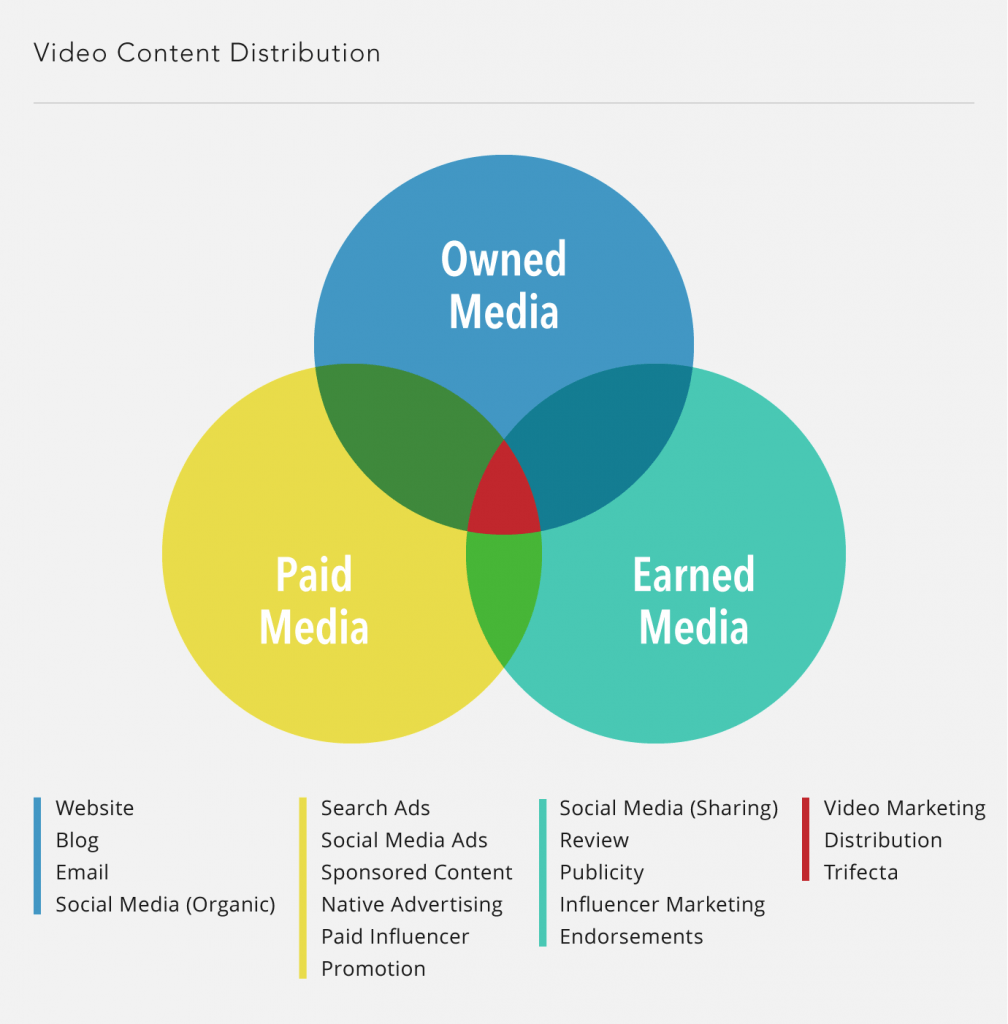 How do you know which of these distribution channels is right for your business?
How do you know which of these distribution channels is right for your business?It can be tough to tell, as there’s no one answer. Many variables are involved, such as your budget and the breadth of your reach.
The good news?
Our team created a resource identifying the eight most reliable online distribution channels for video content.
Step #10: Monitor Your Success, Tweak, Rinse, and Repeat
All right, you just pressed the button to upload your videos into cyberspace. You’re finally getting the chance to share the videos you’ve worked so hard on with your target audience.
… Now what?
It can be daunting to know what to do next after you upload your content. Do you just sit back and pray for good news?
Should you stay glued to your screen, monitoring your watch time and total video views?
Nope!
In fact, your view count typically isn’t even the most important metric to pay attention to measure your success. The metrics you’ll want to monitor will depend on your marketing goals. Here’s a list of the essential KPIs for video marketing to make things easier for you.
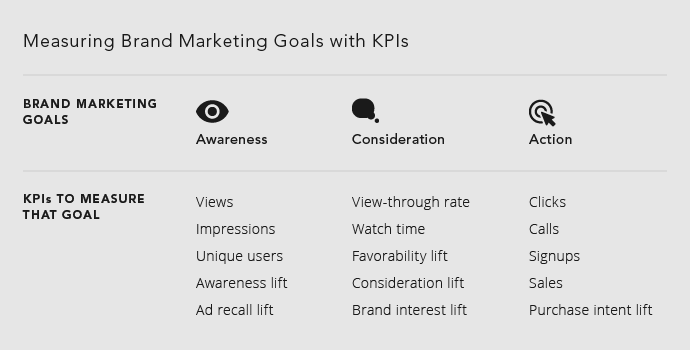
Concluding Thoughts: Getting Your Video Marketing Strategy Off The Ground
Closely follow this guide, and you’ll have everything you need to create, develop, and put into action a successful video marketing campaign.
Video marketing both gets easier and trickier once you start rolling. The good news is that by knowing your KPIs, you can tweak and adjust your strategy accordingly. As long as you pay attention to the hard data – you can experiment with trial and error until you find something that hits big.
It will take a fair amount of experimentation to discover the winning formula for your business, so it’s crucial not to get gun-shy after a video doesn’t perform the way you’d hoped.
Need more digital marketing advice? Go ahead and schedule a call to speak with one of our digital marketing experts today.



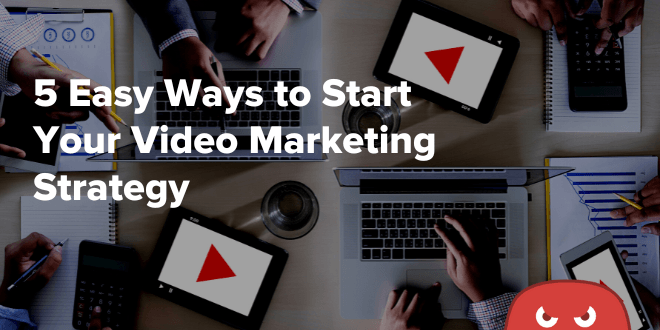

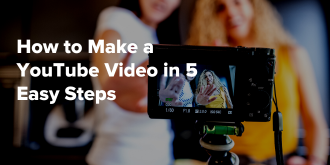
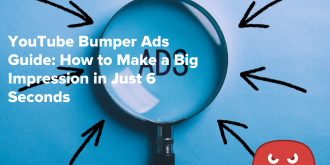


Excellent post on the use of video in marketing; keep it up.
I have been struggling with video marketing and not much of this online however the Hoth helps me yet again. Great Post thank you.
Hi, interesting work!